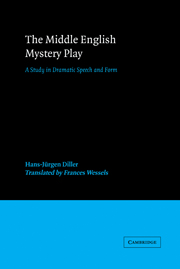Introduction
Published online by Cambridge University Press: 04 March 2010
Summary
In the late 1960s and early 1970s, when the German original of this book was written and published, the study of medieval English drama was still largely text-centred, and this orientation implied certain tacit assumptions: that the four extant cycles were representative of the lost religious drama as well; that the manuscripts preserved gave a fairly accurate picture of the acted texts; that the Corpus Christi cycle was the dominant type of Middle English communal religious drama; and that the pageantwaggon was the typical stage for such a cycle. Of the many other dramatic activities and their socio-economic context, little was known that went beyond the famous Appendixes to Chambers' The Mediaeval Stage. The systematic search of archives for unpublished dramatic records was then just beginning. Our knowledge of the iconography of the medieval theatre was still much more haphazard than it is today: the Early Drama, Art, and Music project started publishing in 1977.
The standard work to which everybody referred, even if it was mainly to criticize it, was Hardin Craig's English Religious Drama of the Middle Ages. Craig, whose book is still the last comprehensive monograph on the subject, epitomized more than half a century of criticism in his claim that the ‘life-blood’ of the religious drama of the Middle Ages was religion and that it represented ‘the strange case of a drama that was not striving to be dramatic but to be religious’.
- Type
- Chapter
- Information
- The Middle English Mystery PlayA Study in Dramatic Speech and Form, pp. 1 - 6Publisher: Cambridge University PressPrint publication year: 1992



